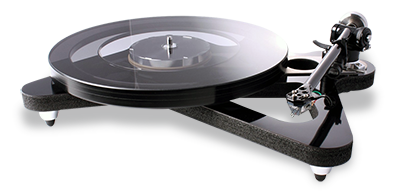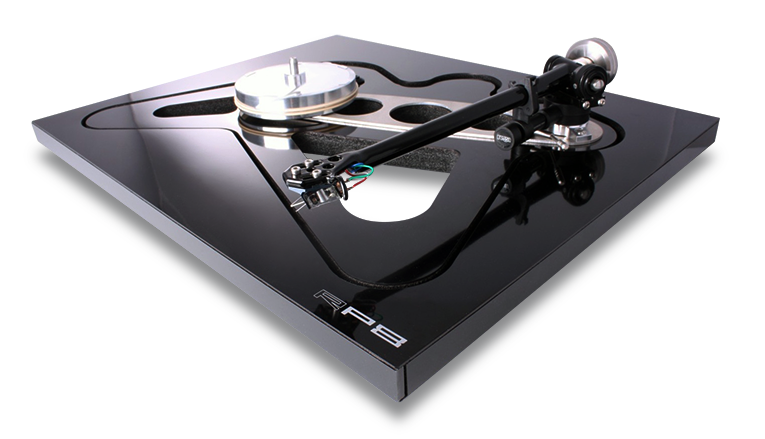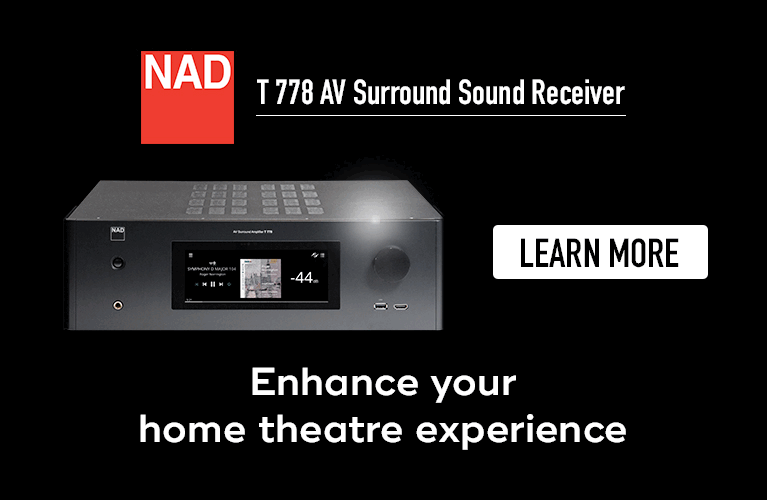
 Over the last four decades, few companies have done as well as Rega Research at making record players. It’s easy to see why: The Essex outfit continuously produces carefully thought-out, sensibly designed turntables that combine class-leading performance with superb value. For an example, one only need look at their 3-series ’tables, a line methodically developed over nearly 40 years. From the first Planar 3 of the late 1970s to today’s RP3, the Rega 3s have been the de facto standard against which other sub-$1000 turntables are judged.
Over the last four decades, few companies have done as well as Rega Research at making record players. It’s easy to see why: The Essex outfit continuously produces carefully thought-out, sensibly designed turntables that combine class-leading performance with superb value. For an example, one only need look at their 3-series ’tables, a line methodically developed over nearly 40 years. From the first Planar 3 of the late 1970s to today’s RP3, the Rega 3s have been the de facto standard against which other sub-$1000 turntables are judged.
But despite the many ways Rega ’tables have evolved over the years, what has remained mostly unchanged is the way a Rega ’table looks: plain, with a flat, rectangular plinth; a straight-tubed, featureless tonearm; and that ubiquitous felt mat. Any audiophile who’s been around the block a few times will tell you: That’s what a Rega ’table looks like. Outside Rega’s own employees, I’ll bet relatively few folks could detect a difference among various 3-series models if those models’ names were masked. Even Rega’s P9 and P25 of yore -- I owned and enjoyed one of the latter for a long time -- look an awful lot like a P3.
Imagine my surprise, then, when I first laid eyes on the Rega RP8: It looks so radically different from every other Rega that I almost didn’t believe it was one. A quick glance at that hollowed-out, skeletal plinth is all it takes to see that this ’table is cutting-edge stuff. Indeed, its design and execution look downright revolutionary compared to the subtly evolutionary tradition of other Regas. Curious to find out more about what makes the RP8 so aesthetically singular -- and, of course, about why it sounded as it did -- I immediately set out about securing one for myself.
Description
Anyone even remotely familiar with Rega knows that they’ve always believed that turntables should be light and rigid. The RP8 is the company’s first model utilizing a skeletal plinth to accomplish this goal. This unique design wasn’t arrived at overnight, however: It was born from an extensive, three-year-long research-and-design effort into getting rid of as much unnecessary mass as possible.
The RP8’s plinth (it’s also used in the flagship RP10) begins life as a core of closed-cell, nitrogen-injected, polyolefin foam. As much as possible of this is machined away, to leave only a frame. This frame is then sandwiched between top and bottom sheets of ultrathin phenolic, to produce what’s known as a stressed-skin structure. This sort of construction confers many benefits, including excellent structural rigidity and quick dissipation of vibrations -- two properties that are the foundation of every Rega turntable. Rega claims that the mass of the RP8’s plinth is only one-seventh that of the plinth of the original Planar 3.
The skeletal frame also features a substantial-looking bearing assembly, on top of which sits a subplatter of CNC-machined aluminum. Atop that sits Rega’s all-new main platter of laminated glass. The platter’s three-layer design is a stroke of genius: Two ring-shaped, concentric platter layers are bonded to the top layer’s underside such that the mass of each successively lower layer is concentrated farther toward the platter’s periphery. Thus, the platter’s mass is greater only where it needs to be: around the rim, instead of over the bearing. This keeps the platter’s center as light as possible, while maximizing both the flywheel effect and rotational stability.

A stressed-beam structure, made from a magnesium top layer and phenolic bottom layer, physically joins the RP8’s hub and tonearm assembly for increased rigidity, greater dissipation of vibrations, and reduced resonance. The tonearm is Rega’s all-new, hand-built RB808. It features CAD-designed enhancements over earlier Rega arms that optimize the distribution of mass throughout the armtube, for increased stiffness. Further improvements include a new, low-mass, vertical bearing assembly and sets of matched, tighter-tolerance bearings and spindles.
Looks like Rega also recognizes that not everyone who appreciates a skeletal plinth can forgo a means of protecting his or her vinyl-spinning rig from prying fingers or curious cats: The RP8 also includes a traditionally shaped (rectangular) outer plinth and dustcover that can be fitted on top. And lest you think Rega has gone all extravagant and forgotten its sensible ways by including that dustcover, think again: It’s the same tried-and-true, plastic-tab-hinged, tastefully simple dustcover used for every Rega turntable since the Carter administration. It’s probably safe to say that Rega recouped their costs on that one a long, long time ago.
Add in the hand-tuned, rigidly mounted, 24V motor; twin drive belts; the outboard, dual-speed, TTPSU power supply; a record mat of pure wool felt; and low-capacitance, RCA-terminated interconnects, and you have a lot of ’table for only $2995 USD. The RP8 can also be purchased with Rega’s own Apheta moving-coil cartridge for $3995, which knocks $795 off the cartridge’s price if purchased separately.
Setup
Like all Rega ’tables, setting up the RP8 was almost a plug’n’play experience. It was really just a matter of pulling the works out of the box, setting the platter atop the subplatter, hooking up the power supply, and plugging it in. If you’re using the outer frame, all that’s involved is setting the inner plinth/platter/tonearm unit within the outer plinth, so that the support feet of the former insert into those of the latter. Three triangulated rubber O-rings inside the outer plinth’s supports automatically center both sets of plinths and feet.
If you opted for Rega’s preinstalled Apheta cartridge, total setup time should be about 20 minutes, including unboxing. For the sake of familiarity, I forwent the Apheta and used my beloved Lyra Delos, which of course added the mounting and aligning of that cartridge to the setup time. And here’s where the only setup snag occurred. Since the RB808, like all Rega arms, lacks any sort of height adjustment for setting vertical tracking angle (VTA), I ordered from Rega two 2mm tonearm spacers to account for the Delos’s greater height over the Apheta. Unfortunately, one of the spacers I received was drilled for previous versions of Rega’s three-point mounted arms, such as the RB1000. This meant that the spacer’s mounting holes were just a smidge too small in diameter, which voided its use with the RP8-RB808 package. Ugh. Luckily, I had my Dremel handy, and bored the holes out to the proper size. If you need spacers for your RB808, make sure you get the right ones.
Listening
After I’d dialed in the Delos, I set the RP8 atop my Target wall shelf, placed on the platter and supplied mat a 200gm reissue of Miles Davis’s Kind of Blue (Columbia/Classic Records CS 8163), pressed the Rega’s power button, and settled in to listen. As soon as I heard the catchy opening bars of “So What,” I knew I was in for a treat. The RP8 sounded excitingly lively, neutrally balanced, and harmonically complete. Music emerged from a silent, inky-black backdrop, and images were precisely rendered in holographic manner, with abundances of spatial and sonic detail.
In fact, the more I listened, the easier it was to hear just how special the Rega was with that last quality: The RP8 resolved more detail than any $3000 turntable had any right to. I was able to hear details in the music I’d never heard before. Thank goodness this wasn’t detail for detail’s sake, but musically significant detail that wasn’t the least bit overblown: all the subtly syncopated ways pianist Bill Evans leans into or out of specific chords for dramatic effect; how he masterfully and ever so slightly varies his touch to emphasize certain notes; how Paul Chambers’s fingers positively bounce on the strings of his warm, woody double bass, imbuing the music with a relaxed feel and a laser-like lock on the rhythm; etc.
But when I really wanted to hear how well the RP8 did detail, I put on “Milkola Bottle” -- richly layered electronica from Airhead’s groove-centric For Years (R&S RS1308LP) -- and let the music wash over me. The Rega allowed each nuanced rhythmic and percussive sample to remain distinct without separating them from the musical whole. This track’s sequence of staccato beats, for example, stood out with greater relief through the Rega than with any other ’table that’s taken up residence in my listening room.
Kind of Blue and For Years also highlighted how well the RP8 ran through the audiophile’s sonic checklist. In fact, hearing how this Rega ’table did bass was something of a revelation. Paul Chambers’s double-bass work on Kind of Blue sounded appropriately weighty, while possessing excellent articulation and pitch definition. And the deep, pounding synth bass on For Years resonated throughout my room with both tautness and suppleness, highlighting the propulsive force that underpins every track on this beat-heavy album. If you thought all Regas had lightweight lows, or that only super-heavy, high-mass ’tables could do bass, think again: The RP8’s deep-bass reproduction was among the best I’ve heard, entirely convincing in both its quality and quantity.

Moving up through the audioband, the RP8’s midrange also sounded well developed. Listening to James Blake’s awesome sophomore effort, Overgrown (Atlas 10LP), I couldn’t help but notice how the Rega accurately conveyed Blake’s voice with all the rich complexity, sensitivity, and nuance that defines his vocal style, and without any hype or artificiality. There was also a fundamental rightness to the way the RP8 reproduced tone without ever sounding too rich or cloying.
The Rega RP8’s treble, too, was exemplary -- pure through and through, well extended and free of grain, without any undue brightness. For example, the cymbal work in Kind of Blue had a sweetness and shimmer similar to what one hears live. Delicate instruments, such as the bells and chimes on a fine reissue of Paul Paray and the Detroit Symphony’s recordings of Debussy’s Prelude to the Afternoon of a Faun and Petite Suite (Mercury Living Presence/Speakers Corner SR90213), sounded especially natural and refined.
Rega turntables have always been known for their pace, rhythm, and timing, and the RP8 carried on this tradition with apparent ease. Listening to “Idioteque,” from Radiohead’s Kid A (Capitol 529590), showed how masterfully the Rega could deliver all the toe-tappin,’ head-bobbin’ energy Thom Yorke and company unleash in this number. I could almost have waked the dead with the way the Rega RP8 made me feel the music’s beat through and through.
But it wasn’t until I played Prokofiev’s Romeo and Juliet, with André Previn conducting the London Symphony Orchestra (Angel SC-3802), that I was able to fully appreciate one of the RP8’s greatest strengths -- its fully developed, ultrawide dynamic range. From Dance of the Knights through Tybalt Recognizes Romeo, on side 2, the Rega deftly tracked both macro- and microdynamic changes, letting through the full brunt of the music’s power and drama. After that, Mussorgsky’s Night on Bald Mountain, with Lorin Maazel conducting the Cleveland Orchestra (Telarc 10042), and Harry Connick Jr.’s We Are in Love (Columbia CK 46146), let me hear how the RP8’s dynamic prowess made for thrilling, captivating, emotionally riveting music each and every time.
While the RP8 had awesome chops by any standard, one aspect of its sound made me think that certain listeners might be looking for more: transient reproduction. With Blake’s Overgrown, for example, I could hear that while the Rega’s attack and sustain sounded complete, it wasn’t delivering quite as much trailing-edge and decay information as some other, more massive ’tables do. But I never heard this as anything missing from the music. I can’t help thinking that the Rega may have been more accurate in this regard than those heavier ’tables; in fact, I’m becoming increasingly convinced that other ’tables are letting through more vibrational resonances that then masquerade as extra harmonic decay.
Comparison
I decided to compare the RP8 with my own combo of a fully restored Thorens TD-124 turntable and an Ortofon AS-212s tonearm. Anyone who’s seen the classic Thorens knows that it’s a thoroughly complicated machine, designed with all of the precision its Swiss makers had to offer over 50 years ago. The Ortofon AS-212s, a modern arm, is also wonderful in every way, with excellent build quality, precise operation, and convenience and adjustment features the Rega RB808 arm lacks. My Thorens-Ortofon combo is nestled into an ultra-massive, custom-built, constrained-layer-damped plinth that adds to the system’s overall heft and solidity.
Hearing how the lightweight Rega RP8 compared with the massive Thorens-Ortofon combo proved instructive and surprising. Playing the aforementioned James Blake and Airhead albums on the Thorens TD-124, I was immediately reminded of why I’ve used this ’table as my reference for the past four years: Its big, bold, slightly diffuse sound easily fills a room and makes for an enveloping listening experience. I also heard the higher quantities of transient-decay information and bass that are the hallmarks of mass-loaded designs. But those were the only areas in which the Thorens was the clear winner.
Listening to the Boston Symphony Chamber Players in three sonatas by Debussy (Deutsche Grammophon 2530049), I could hear that the Rega RP8 simply sounded more exciting overall, with more of the you-are-there realism one hears at live performances. In terms of soundstaging and imaging, the RP8’s soundstage was slightly smaller in width and depth, but the Rega RP8 imaged with greater clarity and precision, and noticeably more detail. The Rega also produced more natural tone colors overall, with cleaner, more extended treble. It also gave a better sense of space around instruments without erring toward an overly airy, phasey sound.
With Madeleine Peyroux’s Careless Love (Rounder/Mobile Fidelity Sound Lab MFSL1-284), I could also hear that the Rega sounded more continuous and cohesive, in terms of both its frequency spectrum and its musical delivery. It made music with a more singular voice, with a better sense of note-to-note flow, than my Thorens rig, allowing me to more easily forget the sound and enjoy more of the music. Peyroux’s voice also sounded more realistically complex, with more of her raspy, croaky vocal goodness intact.
Don’t get me wrong -- the Thorens TD-124 is still a fine-sounding ’table, especially considering that it’s over half a century old. The fact that it’s remained not only relevant but competitive with today’s best turntables on both musical and sonic grounds speaks volumes about its quality. And in terms of bass quantity and transient-decay information, it’s almost a standard-bearer in its class. But when all was said and done, I preferred the Rega RP8 for its high excitement factor, more natural tonal character, and greater musical expressiveness.
Conclusions
Although I was already familiar with several Rega turntables, none could have prepared me for how good the RP8 was. This outstanding record player delivers musical and sonic goodness in spades. Its blend of class-leading detail, exciting yet natural tonal balance, and exemplary dynamics will have you spinning your favorite LPs for one marathon listening session after another. And its surprising low-end potency and articulation will make a believer of anyone who thinks excellent bass is the purview of only gargantuan, mass-loaded ’tables.
Of course, it’s possible that the Rega may not be the perfect record player for everyone. There is, after all, the matter of its ever-so-slightly-diminished presentation of harmonic and transient-decay information. Those of you looking for lingering transients may want to first hear for yourself how the Rega does it. And those who are adamant about spending more than the RP8’s insanely high-value price of only $2995 (or $3995 with Apheta cartridge) should also look elsewhere.
You’re going to have to spend a heck of a lot more than $2995 to best the Rega RP8 in any major way. Anyway, that would be to miss the point of this ’table: The RP8 makes music in the most convincing and communicative way I’ve yet heard from a reasonably priced turntable. That it does so in a way that satisfies both of my audio inner selves, the music lover and the sound hound, is mighty special indeed. For most folks, those reasons will be enough for them to give the Rega a go. But add to those its incredibly easy setup and its consistent, reliable operation, and it’s a no-brainer.
I bought mine. I can’t think of a more enthusiastic recommendation.
. . . Oliver Amnuayphol
olivera@soundstagenetwork.com
Associated Equipment
- Loudspeakers -- Aperion Audio Verus Grand Tower and Verus Forte Tower, Ocellia Calliope.16
- Integrated amplifiers -- Marantz PM-KI Pearl, Line Magnetic LM-211IA
- Phono preamplifier -- Graham Slee Revelation M
- Step-up transformer -- Custom-made Sowter Magnetics 9570 1:10 transformer
- Sources -- Thorens TD-124; Ortofon AS-212s tonearm; Lyra Delos cartridge; Denon DCD-CX3 SACD/CD player modified by Reference Audio
- Analog interconnects -- Custom solid-core silver/Teflon RCA cables, Blue Jeans Cable LC-1
- Power cords -- Wireworld Aurora 5.2 and Electra 5.2
- Speaker cables -- Canare 4S11 Star-Quad
Rega Research Limited RP8 Turntable
Price: $2995 USD ($3995 USD with Apheta MC cartridge).
Warranty: Three years parts and labor.
Rega Research Limited
6 Coopers Way
Temple Farm Industrial Estate
Southend on Sea
Essex SS2 5TE
England, UK
Phone: +44 1702-447660
Fax: +44 1702-432427
Website: www.rega.co.uk
US distributor:
The Sound Organisation
159 Leslie Street
Dallas, TX 75207
Phone: (972) 234-0182
E-mail: info@soundorg.com
Website: www.soundorg.com
Canadian distributor:
Plurison
313 Marion Street
Le Gardeur, Quebec J5Z 4W8
Phone: (866) 271-5689
Website: www.plurison.com






















